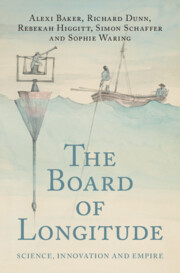Book contents
- The Board of Longitude
- The Board of Longitude
- Copyright page
- Dedication
- Contents
- Figures
- Tables
- Boxes
- Acknowledgements
- Timeline
- Abbreviations
- 1 Introduction
- 2 Sailing the Oceans and Seeking Longitude before 1714
- 3 Launching the Eighteenth-Century Search for Longitude
- 4 The Early Commissioners in Transition
- 5 The Birth of the Board of Longitude
- 6 Time Trials
- 7 Manufacturing the Nautical Almanac
- 8 Managing, Communicating and Judging Longitude after Harrison, 1774–c. 1800
- 9 A Practical Institution Weighed Down by Impractical Proposals?
- 10 What Is an Observatory? From the Metropolis to the Cape
- 11 The Death and Rebirth of the Board of Longitude
- Epilogue
- Book part
- Glossary
- Bibliography
- Index
5 - The Birth of the Board of Longitude
Published online by Cambridge University Press: 11 April 2025
- The Board of Longitude
- The Board of Longitude
- Copyright page
- Dedication
- Contents
- Figures
- Tables
- Boxes
- Acknowledgements
- Timeline
- Abbreviations
- 1 Introduction
- 2 Sailing the Oceans and Seeking Longitude before 1714
- 3 Launching the Eighteenth-Century Search for Longitude
- 4 The Early Commissioners in Transition
- 5 The Birth of the Board of Longitude
- 6 Time Trials
- 7 Manufacturing the Nautical Almanac
- 8 Managing, Communicating and Judging Longitude after Harrison, 1774–c. 1800
- 9 A Practical Institution Weighed Down by Impractical Proposals?
- 10 What Is an Observatory? From the Metropolis to the Cape
- 11 The Death and Rebirth of the Board of Longitude
- Epilogue
- Book part
- Glossary
- Bibliography
- Index
Summary
Focusing on the period from the early 1760s to the resolution of the John Harrison affair in 1773, this chapter argues that it was only in this period that the ‘Board of Longitude’ came into being. This was largely in response to the debates surrounding the sea trials of Harrison’s fourth marine timekeeper (H4) and two other longitude schemes – Tobias Mayer’s tables and method for lunar distances and Christopher Irwin’s marine chair for observing Jupiter’s satellites. The transformation into a standing board manifested in regular rather than sporadic meetings and the appointment of a secretary to keep the Board’s papers in order as the Commissioners, for whom astronomer Nevil Maskelyne would become a central figure, sought to defend their decisions over the allocation of monetary rewards. The debates with Harrison, which focused on questions of adequate testing and the judging of trials, disclosure and replicability, and accusations of self-interest, would see the Board harden its stance through the use of legislation to ensure resolution. The Harrisons and their supporters, by contrast, sought to bolster support through lobbying and publication of their claims.
Keywords
- Type
- Chapter
- Information
- The Board of LongitudeScience, Innovation and Empire, pp. 89 - 121Publisher: Cambridge University PressPrint publication year: 2025

